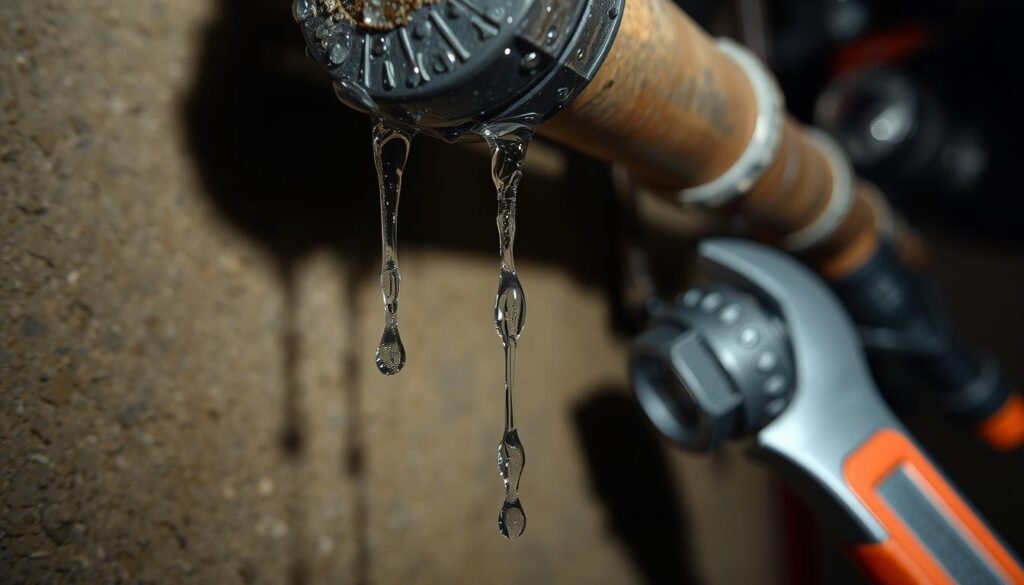Water leaks can really hurt your home. They can lead to expensive fixes and health risks. It’s key to find leaks early to keep your home safe.
Finding leaks early can save you a lot of money and keep your home’s value up. From dripping faucets to hidden pipe bursts, every leak can cause big problems if not fixed. Let’s learn how to spot and fix water leaks in your home.
Understanding Common Signs of Water Leaks
Spotting leaks early can prevent expensive water damage. Let’s look at important signs that might show hidden leaks in your home.
Visual Indicators of Hidden Leaks
Watch for these signs of water damage:
- Discolored walls or ceilings
- Peeling paint or wallpaper
- Warped flooring or baseboards
- Mold growth in unexpected areas
Unusual Sounds and Smells
Your senses can warn you of hidden leaks:
- Dripping or rushing water sounds when no taps are on
- Musty odors in rooms or closets
- Gurgling noises from pipes or drains
Monitoring Your Water Bill for Unexpected Increases
A sudden jump in your water bill might mean a leak. Keep track of your water use and compare it to past months to find any odd changes.
| Month | Water Usage (Gallons) | Bill Amount ($) |
|---|---|---|
| January | 5,000 | 50 |
| February | 5,200 | 52 |
| March | 7,500 | 75 |
By being alert and knowing these signs, you can find hidden leaks before they harm your home.
Water Leak Detection Methods and Tools
Finding water leaks early can save you money and prevent damage. Let’s look at the tools and technology for finding leaks at home and by professionals.
Professional Detection Equipment
Plumbers use special tools to find leaks. Acoustic sensors listen for water sounds. Thermal cameras spot leaks by temperature changes. Ground-penetrating radar finds underground leaks without digging.
DIY Detection Techniques
You can find leaks at home with simple steps. Add food coloring to your toilet tank to see leaks. Moisture meters find damp spots in walls or floors. Check your water meter before and after no water use to find hidden leaks.
Smart Water Monitoring Systems
Smart home tech now includes water sensors. These systems alert you to water issues through apps. Some can turn off your water if they find a big leak.
| Detection Method | Best For | Cost Range |
|---|---|---|
| Acoustic Sensors | Hidden pipe leaks | $500 – $2,000 |
| Moisture Meters | Wall and floor dampness | $30 – $100 |
| Smart Water Sensors | Continuous monitoring | $200 – $500 |
High-Risk Areas in Your Home
Your home has many spots where leaks can happen. Knowing these areas can help avoid costly water damage. Let’s look at the most likely places for leaks in your house.
Bathroom and Kitchen Vulnerabilities
Bathrooms and kitchens are where leaks often occur. Look under sinks, around toilets, and behind appliances for moisture. Signs like loose tiles, cracked grout, or warped flooring can mean hidden leaks.
Basement and Foundation Weak Points
Basements are often hit by water. Check walls for cracks or dampness. Also, make sure your sump pump is working right. Small foundation problems can grow into big issues if not fixed.
Outdoor Plumbing Considerations
Don’t overlook outdoor plumbing during your inspection. Leaks can happen in sprinkler systems, outdoor faucets, and pool equipment. Look for wet spots in your yard or unexpected water bill increases.
| Area | Common Leak Sources | Inspection Frequency |
|---|---|---|
| Bathroom | Toilets, showers, sinks | Monthly |
| Kitchen | Dishwasher, sink, refrigerator | Monthly |
| Basement | Walls, floor, sump pump | Quarterly |
| Outdoor | Sprinklers, faucets, pool | Seasonally |
Regular checks of these high-risk areas can save you from expensive repairs. If you’re unsure about any plumbing issues, don’t hesitate to call a professional for a thorough home inspection.
Emergency Response and Temporary Fixes
When you see a leak, act fast. This guide will show you how to handle a leak emergency. You’ll learn DIY repairs until the pros arrive.
Immediate Actions to Take When You Find a Leak
First, turn off the water supply. Find your main water valve and switch it off. Then, move out any things you value from the area.
Start drying the space. Use towels, mops, or a wet vacuum to soak up water.
Essential Tools for Quick Repairs
Keep these tools ready for DIY fixes:
- Pipe repair clamps
- Plumber’s tape
- Epoxy putty
- Adjustable wrench
- Bucket
For quick fixes, wrap plumber’s tape on small leaks. Use epoxy putty for cracks. Pipe repair clamps are good for big leaks on straight pipes.
When to Call a Professional Plumber
DIY fixes are okay sometimes. But, some problems need a pro:
| Situation | Why Call a Pro |
|---|---|
| Large or persistent leaks | May indicate serious pipe damage |
| Leaks in walls or ceilings | Risk of structural damage |
| Sewer line issues | Health hazards and complex repairs |
| Multiple leak points | Sign of system-wide problems |
Quick action and the right tools can help. But, if unsure, call a pro for lasting fixes.
Conclusion
Stopping water leaks is key to protecting your home. Keep an eye out for odd sounds, smells, or changes in your water bill. This helps you catch leaks early.
Check places like bathrooms, kitchens, and basements often. These spots are more likely to have leaks. Using both DIY and professional methods can find hidden leaks.
Smart water monitoring systems add extra protection. If you find a leak, act quickly to avoid big damage. This can save your home a lot of trouble.
Have basic tools ready and know when to call experts. By following these steps, you’re protecting your home from water damage. Stay alert, act fast, and keep your home safe and dry.
FAQ
How often should I inspect my home for water leaks?
Check your home for water leaks at least twice a year. But, watch for leaks during cleaning and after bad weather. Also, look out for changes in your water bill.
What are some common signs of hidden water leaks?
Look for water stains, musty smells, and mold. Also, check for warped floors, peeling paint, and strange sounds. An unexpected rise in your water bill is another sign.
Are there any DIY methods to detect water leaks?
Yes, you can use DIY methods to find leaks. Check your water meter when all water is off. If it moves, you have a leak. You can also use food coloring in your toilet tank.
What areas of my home are most prone to water leaks?
Bathrooms and kitchens are most likely to have leaks. Also, check basements, water heaters, foundations, and outdoor plumbing. These areas are often vulnerable.
What should I do if I find a water leak?
First, turn off the water supply. Then, try to stop the leak and move things away. For small leaks, you can use plumber’s tape. But, call a plumber for big leaks or if unsure.
Are smart water monitoring systems worth the investment?
Smart water systems can be a good buy. They catch leaks early and save water. They cost money upfront, but they save you from damage and can lower your bills.
How can I prevent water leaks in my home?
Regularly check your plumbing and appliances. Watch your water bill for sudden changes. Think about getting leak detection devices. Also, be careful what you flush and know where your main shut-off valve is.


